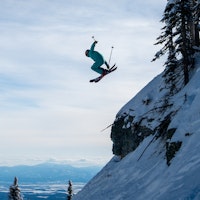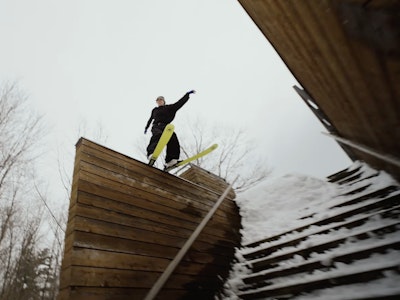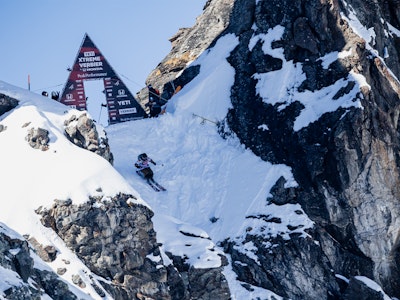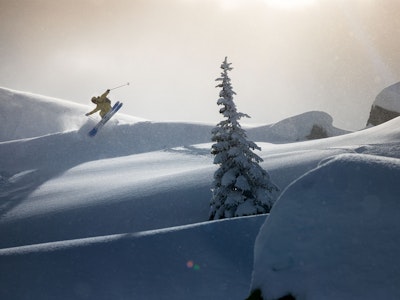“To me, he seemed like a guy going through the motions,” says filmmaker Constantine “CP” Papanicolaou of the Seth Morrison he knew in 2009. “He’s the guy who cruises around, makes
awesome turns and, when conditions are perfect, hucks a big cliff and gets everyone excited.”
After 20 years of professional big-mountain skiing, Morrison’s seasons had grown routine. It was about what he called “stunt man skiing.” Turn, turn, huck, straight line. Perfect snow. Blue sky. Appearances, catalogue shoots, interviews, autograph signings. What used to be all about the skiing had turned into not much more than a job.
Two years later, Morrison is atop the Mallory Route, a wild, exposed, fall-you-die classic extreme skiing descent on the abyss of rock known as the North Face of the Aiguille du Midi in Chamonix, France. There’s a meter of fresh snow atop a 10-day old base and it’s a cobalt clear day in the Alps. Morrison, JP Auclair, Nate Wallace and Chris Figenshau watch the first group of the day kick off multiple avalanche plates. The slough is running 9,000 feet to the valley floor. One at a time, they drop onto the crème brûléed face. When it gets steep, narrow and peppered with rocks, it’s time to rappel.
Facing the mountain, Morrison’s skis are on as he lowers himself down the 55-degree rock garden then downclimbs to the next rappel. As he nears the end of the second skiable face, he sees the consequence below: one slip of an edge and he’d tomahawk down a long stretch of rock before falling off a cliff. They make it to the 1,000-foot couloir in time for ideal conditions. Four-and-a-half hours later, Morrison is drinking the best tasting beer of the trip. Due to logistical constraints, the run doesn’t make it in The Ordinary Skier (TOS), the documentary about Seth that released this fall. But the Mallory is the culmination of two seasons, four trips and 15 weeks spent in the Mecca of ski mountaineering.
When Oakley approached Morrison in 2009 about making a film, he took the opportunity to become a student again, to delve into a new era of his career—one with harnesses, ice axes and near death experiences.
Morrison has always escaped the demons in his head by throwing himself into sports that require hyper awareness. But the feelings that surround a big descent in Chamonix—fear, excitement, relief, joy—surfaced for Morrison for the first time in 15 years as he rediscovered the freedom skiing delivered before a camera was ever involved.
“It’s not about adrenaline rush,” says Morrison. “It’s about the concentration, the turn-to-turn, the focusing… it’s the only time I find peace in my life.”
ON LOCATION
Objective hazards, such as seracs, avalanches, crevasses, rock fall and bergschrunds are dangers that skiers and climbers have no control over (whereas equipment failure or falls due to inadequate technique are subjective hazards). Nowhere is this more obvious than in the mountains surrounding Chamonix, the town at the base of Mont Blanc, bordering Switzerland, France and Italy. Chamonix is the birthplace of steep skiing for one reason—the Aiguille du Midi. Delivering mountaineers, tourists and skiers from the 3,379-foot valley floor to the 12,605-foot summit, it climbs 9,200 vertical feet in just 20 minutes. The tram offers unparalleled access to some of the most dangerous mountains in the world.
As Kye Petersen says in the film, skiing is only one-third of the picture in Chamonix. The rest is climbing and simply getting through the mountains alive. “It’s the finale of what you want to be doing,” says Petersen in TOS.
“I always learn something from Seth whenever I ski with him,” says Whistler based Petersen, Morrison’s partner on his first film trip to Chamonix. “Usually it’s skiing technique and things like dealing with film crews, but this trip was a little different because he was new to the mountaineering style of lines we were skiing, new to the mountains around Cham and new to the equipment we were using. So it was all just a big learning experience.”
“You can see it in the film,” says CP. “When Seth first arrives in Chamonix, he almost looks intimidated. Chamonix was totally new for him.”
The locals weren’t too welcoming, either. “No one was interested in helping and no one took us seriously,” says CP. “Nate was the only one who saw some value in the idea.”
Oakley Sports Marketing Manager Greg Strokes, who spent 12 weeks on the road with the TOS crew, had a friend in Chamonix by the name of Nate Wallace who he thought might make a good addition to the crew. The Mammoth Lakes native had spent the last ten winters in Chamonix, notching first descents with Pierre Tardival, surviving large avalanches (including one that destroyed his apartment) and earning a reputation as one of the most legit mountain men in a land of mountaineers.
“Nate is like Peter Pan,” says CP. “He’s a kid who hasn’t grown up. He’s really the ultimate ski bum, the guy who never sold out. He’s had plenty of opportunities. All these pro skiers have made huge compromises—Nate hasn’t compromised anything.”
A decade of high-risk ski mountaineering has a way of making a skier “Chamified.” Symptoms include bizarre social skills, holding intense stares for prolonged periods of time and facing your own mortality on a regular basis.
“Nate’s gravitational energy is so great that we bashed heads pretty hard at first,” says CP. “We almost got into an actual physical fight.”
Days would go by without getting any footage. There was no schedule, no plan. And for a duo of Type A personalities like Morrison and CP, it was frustrating.
“But then I realized Nate’s real-time approach to skiing was the safest tactic,” says CP. “It became Nate’s way. I realized I needed to orbit around Nate and I couldn’t even think about the alternatives. I just needed to be there with the camera rolling.”
Wallace eventually evolved into an essential character in the film.
After two seasons, four film trips and 15 weeks in Chamonix, the film morphed from a documentary on Morrison’s past to “story about a guy who has to get his soul back,” says CP.
“People assume he has everything he wants,” says CP. “But he has the type of personality that doesn’t allow him to enjoy what he’s accomplished.”
For more than 15 years, ski movie crowds have anticipated Morrison’s segment like free booze. No other big-mountain skier has come along who can rev up an audience like him. His maching, graceful turns and signature huge back flips off massive features still draw vociferous cheers at ski film premieres the country over. Since 1993, he’s appeared in more than 40 films.
Morrison has made Powder Magazine’s Reader Poll, in which readers vote the Top 10 skiers of the year, since its inception—a tangible accolade, reaffirming his popularity year after year. Ironic for a guy who goes out of his way to avoid people most of the time. Morrison doesn’t mind mountain biking solo. He skis a lot by himself, hunts alone and is building a house in the backwoods of Colorado only accessible by snowmobile in the winter. Despite spending two decades in high-profile Summit County, he’s perhaps the lowest profile ski celebrity out there.
“It’s easy to see Seth as a bit of a hard ass, or as an introverted recluse,” says Pep Fujas, who filmed with Morrison for TOS in South America. “But in reality, he’s surprisingly talkative, very approachable, cordial and well spoken.”
“Filming with Seth is different than filming with anyone else,” says Sean Pettit who filmed with Morrison in Retallack, the BC cat operation in which Morrison is a part owner. “He’s super quiet and likes to venture off. He doesn’t have to try when he’s shooting. He hates the camera. We just talk about whatever. That’s what I like—it’s like a normal, relaxed day of skiing. He avoids ordeals at any cost, even if that means getting up in the middle of a meal and leaving without saying a word.”
Morrison isn’t a natural optimist, but it’s his environment that has bred a realist. He won’t tell you he’s excited for a trip. He’ll remind you that it’s work. He has spent a lifetime “slow roasting” in Alaska, “hot tinning” in South America and “scratching” around in New Zealand. When something as fickle as weather determines a trip’s success, there’s no point in becoming emotionally attached to anything except the present moment.
The late Doug Coombs said Morrison takes it as it comes, including conditions. “He’s not a whiner. He’s very accepting, which isn’t common with these so-called ski heroes. They want it perfect so they can look perfect.”
Fujas believes that’s testament to Morrison’s unwavering passion for skiing.
“He’s not the guy who only goes out to film. He’s still up there, snow or shine, whether it’s pow, crud or ice.”
In Chamonix, Morrison learned to manage a different breed of fear. Rather than the flash of straight run, or a quick huck, he spent hours upon hours managing anxiety on high-consequence runs.
“Seth doesn’t show much emotion,” says CP, “But at the bottom of some of these runs, you could tell he was excited. I think some of the runs scared the shit out of him.”
“When we got there, I had no idea where you could go skiing,” says Morrison. “Each trip was a stepping stone—we became more comfortable, more acclimatized. By the end you could say I was reborn in way.”
ROUTES SKIED
PRODUCTION
“The whole trip was a constant challenge that tested our patience,” says Fujas, who accompanied Morrison on a fruitless search for decent snow in South America while filming for TOS. For example, when the crew arrived in Termas de Chillán, the fog closed all the upper lifts and the rain and sleet turned to snow to slop. As the weather cleared, the wind came, then the fog. They found rotten snow in Portillo and forgot the camera battery for the only good shot in Cerro Catedral.
“It’s the most challenging movie I’ve made,” says CP, who directed Tanner Hall’s Show & Prove (2006), Believe (2007) and The Massive (2008). “Mostly because it’s taken so much time.”
Over the course of two years, CP and Morrison spent 26 weeks on the road, skinned 120 miles and filmed more than eight terabytes of footage.
“CP documented every step,” says Morrison. “He likes to get a lot of different angles, multiple times. And he’s a one-man show. We were constantly hiking and we were filming a lot of on-slope interviews, which makes for difficult filming. CP was always hauling the rig and the tripod…it was a lot of extra work for him.”
CP wasn’t involved in making ski movies before 2004. He happened to be on vacation in New Zealand when Morrison and his Stars, Skis & Hucks crew needed a cameraman. Strokes took notice of CP’s earlier films, including Butter and Chapter 3 and was impressed with his more recent Tanner Hall films. He’s a skilled storyteller and, of equal importance, CP can keep up with the fastest skiers. Once Oakley decided to make a film about Morrison, CP was the natural choice.
Over the past two years, CP has spent cumulatively more than six months with Morrison and perhaps knows him better than anyone these days.
“CP thinks everything through, is super detail oriented and knows what he wants,” says Fujas. “Sometimes it’s annoying because we have to repeat a transitional shot so many times to get it right. But being a skier himself, he knows how to shoot skiing. I thought it was going to be a pain to shoot with the RED camera, but CP was on it and never missed a beat.”
“He’s not going to say it’s sick when it’s not,” says Pettit. “He’ll tell you exactly how it is. Everything he shoots is gold. He has an obvious eye for skiing.”
CP stresses that TOS isn’t a ski movie. He studied the art of storytelling and examined the formats of other action-sport documentaries like DogTown and Z-Boys and Riding Giants. There is no voice-over and the film features an original, orchestrated score—the first for a ski film. He’s hoping the audience broadens from hardcore skiers to people who ski a couple times a year—a different crowd than the one who sees every ski film, every year.
“I’m hoping people get an understanding of what motivates him,” says CP. “I hope they feel what it’s like to go on a ski adventure. I hope they take something away that’s applicable to their own experience.”
CP describes the film as a part documentary, part reality TV. “The Chamonix stuff is high energy and the older footage has this Ken Burns vibe.”
Whereas the quantity-over-quality-get-every-shot-in-one-blue-bird-day formula of ski porn maintains a fantastical illusion, TOS is down and dirty. The original plans involved a heli and a Cineflex, but a week into the crew’s first trip, it became apparent that Chamonix wasn’t meant to be filmed that way. The only mechanized assistance the crew would receive would be from the Aiguille du Midi, the highest vertical cable car in the world. JP Auclair joined Morrison in Chamonix last season and points out that the goals while filming there were different from any other ski film trip.
“On a typical heli film trip, everything happens very fast—the style is aggressive and committed,” he says. “From a great distance and within minutes, you make a call on whether or not you’re skiing a run. Skiing a line very fast just minutes after you’ve seen it for the first time comes with its own style of intensity.”
Auclair says things can get equally as intense while traveling on foot, but that the experience is entirely different. For once, he could take all the time he needed to assess a slope.
“There’s usually a quest for perfection,” he says. “I was used to chasing the perfect run with perfect weather, perfect conditions. Perfection was out of the picture on this trip. The main goals were learning, exploring and coming back in one piece. The satisfaction came from doing the run itself rather than knowing you just got a good shot for the movie.”
MISE-EN-SCENE
On each trip back to Chamonix, still photographers Christian Pondella and Chris Figenshau transformed more and more into filmers as they used their digital SLRs to shoot video that could never have been documented with the RED and its massive tri-pod, extra batteries, lenses, video screen and cables.
“A lot of filmers don’t even need to ski to film,” says CP. “In Chamonix, you have to skin, climb and get in gnarly areas where if you do anything to prolong the process, you’re putting everyone at risk. The longer you’re exposed, the more likely something is to happen.”
Fifteen weeks in Chamonix over the course of two years might seem like an extended film window, but as CP says, the odds are against you.
“You can show up to Alaska for a month and there’s a 90-percent chance you’ll get something worth filming,” he says. “In Chamonix, we didn’t get anything in four weeks. There are lines that don’t come around for 10 years. You have to be there—you have to live there, hear the stories.”
CP assumed Chamonix would be the film’s final chapter, but while struggling with the initial edit in the chalet one afternoon, Morrison made a comment that helped dictate the film’s focus: “You know this movie is about Chamonix, right?”
CAST
The other characters in the film—Kye Petersen, JP Auclair, Pep Fujas, Sean Pettit, Dan Treadway—aren’t so much following Morrison, as they are on a parallel journey. They are allies and partners, wired in a similar way.
Morrison skied with Petersen on his first film trip to Chamonix and Auclair the following season. With a photographer, CP, Wallace and Morrison, there was only room for one partner at a time on the kind of routes the TOS crew was skiing.
“Each person climbing up and even skiing down adds time to your day and increases the danger,” says Morrison. “You want the smallest party possible.”
“The mountains are bigger, but they’re more accessible to everyone,” says Petersen. “It’s a hard place to film a movie—you need a tight crew and a lot of time.”
It was Petersen’s fifth trip to Chamonix.
“There was no mentoring going on,” says CP. “Kye is a super-natural kid. He was born into skiing and already has a lot of it figured out. His comfort level with stuff is unbelievable. He’s not afraid. He’s not completely there. He’s able to ski on icy and scary shit and not worry about falling. He was jumping off stuff where you fall you die.”
Though the 21 year old was born with skiing in his DNA, he he defies the assumption that ski mountaineering should come later in a ski career.
“He’s super rambunctious,” says CP. “Part of me has a lot of respect for Kye and part of me hated having to deal with him. He thinks filming is a waste of time.”
Auclair’s background of moguls, racing and park skiing didn’t prepare him for extreme skiing in the Alps, but he’s been drawn to ski mountaineering since Glen Plake took him around a small Italian resort in 2001.
“I was on a film shoot for PBP’s Propaganda and Plake was traveling through the Italian Alps,” say Auclair. “He called me up and said ‘I’m coming to pick you up—you need to come experience this.”
Auclair skied some of his first couloirs and used skins for the first time.
“He had all these ices axes, ropes and carabiners and kept pointing out steep lines that he said were going to be good come spring,” remembers Auclair. “It opened my mind to a whole different way of enjoying the mountains. I knew I’d eventually gravitate back to the Alps someday.”
After spending time with Morrison in Alaska, Auclair knew a trip to Chamonix was “a golden opportunity.” Auclair says the fact that Morrison was somewhat new to alpinism made him a great teacher.
“He made sure to tell me details that veterans wouldn’t have bothered explaining,” says Auclair. “Without him, I would have often been left to figure things out on my own. Given the fact that I was way out of my comfort zone, it was reassuring to have Seth there.”
Auclair’s scariest moment of the trip was the least sensational looking—a big, wide-open face on the Mont Blanc du Tacul. In fact, the run itself is a crevasse field ending in serac falls. When Auclair and Morrison skied it, the first section was bulletproof ice.
“It wasn’t very steep at all, but for the first time, I had a taste of how it feels to have a hard time holding on to the mountain,” says Auclair. “It felt like the ice was gravity’s perfect accomplice to pull me towards the crevasses. My edges were as sharp as razors and it still felt as if the mountain was deciding on the rate at which I’d be making my way down.”
Auclair learned techniques to safely travel in the alpine, but he says the most important learning was introspective.
“I learned about myself, about how I feel in these mountains,” says Auclair. “I think I’ve really found something that suits my approach and personality. I’ve realized it’s not so much about how difficult or exposed a run might be, but rather about the pace you take to accomplish it. I absolutely loved the fact that you could dedicate a whole 12 hours for just one run. The whole time you are fully there, focused and in the moment. It’s beautiful.”
BY THE NUMBERS
EPILOGUE
After two years of production, The Ordinary Skier premiered September 9, 2011 in Seattle, Washington to a packed King Cat Theater.
The showing coincides with one of Seattle’s hottest days of the summer, making for miserable conditions inside the oversold, ancient theater lacking AC. People are visibly sweating. Sean Pettit takes his shirt off. It’s so hot the projector sputters out, cutting the visual not once but three times. But instead of bolting for the bar, the crowd remains seated. It’s even quiet. In a documentary with zero jib shots, zero dolly shots and zero uses of the world “stoke” the predominantly young group is captivated.
After touring with the film to Vancouver, Zurich, Oslo and Stockholm, Morrison returns to the West Elk Mountains to work on his custom log home. The place is hidden in the woods, solar powered and completely off the grid. It’s beautifully crafted, as you’d expect from Morrison, but with no more room than necessary.
Though he’s moving off the grid, Morrison isn’t going feral. He’ll still be traveling more than 150 days a season filming segments for Teton Gravity Research. In 20 years, there will still be skiing opportunities for Morrison as long as he wants them. He’ll still be appearing in ski movies, launching signature lines and going on missions to unexplored areas.
He’s always kept a base in Summit County, convenient for frequent trips to DIA or early-season laps on East Vail, the sidecountry area Morrison knows better than anyone. If his cabin is finished by winter, he’ll split his time between there and Frisco, settling into the cabin full-time, eventually.
“I would still like to ski East Vail early season,” he says. “But then again, it’s time for a change.
“The need for adventure has always been there,” he says. “But the trips just get more remote or challenging as we evolve. Experience opens new doors. Leaving behind what you know and getting out of your element… that’s what it’s about for me.”

![[GIVEAWAY] Win a 4-Night Karma Campervan Rental and go Ski the Powder Highway](https://www.datocms-assets.com/163516/1767816935-copy-of-dji_0608-1.jpg?w=200&h=200&fit=crop)


![[GIVEAWAY] Win a Legendary Ski Trip with Icelantic's Road to the Rocks](https://www.datocms-assets.com/163516/1765233064-r2r26_freeskier_leaderboard1.jpg?auto=format&w=400&h=300&fit=crop&crop=faces,entropy)





![[GIVEAWAY] Win a 4-Night Karma Campervan Rental and go Ski the Powder Highway](https://www.datocms-assets.com/163516/1767816935-copy-of-dji_0608-1.jpg?auto=format&w=400&h=300&fit=crop&crop=faces,entropy)
